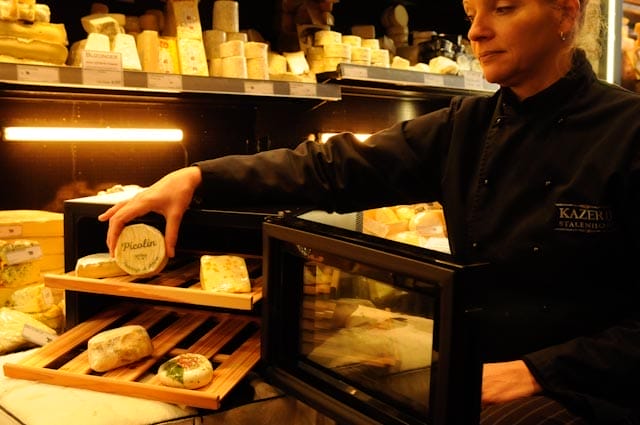Did you know that the way you store your cheese is almost as important as the cheese you choose? Cheese is like wine; it needs the right care to mature perfectly. But don’t worry, you don’t have to be a cheese expert to keep your cheese fresh for longer. That’s exactly where I come in. And, you may not have even thought about a cheese refrigerator, but let me tell you: a special cheese climate cabinet from CoolVaria can make all the difference. With a smaller 25-litre version for the casual cheese lover to a larger 105-litre version for the real collector, there’s something for everyone.
The Basics of Cheese Preservation
Starting with the basics, storing cheese may seem simple, but there’s more to it than you might think. Soft cheeses are best kept at a temperature of 5 to 8 degrees, while hard cheeses such as Gouda are best kept at a slightly higher temperature of 8 to 15 degrees. The secret? Keep the cheese in its original packaging if you can, and if you’re going to eat it, take it out of the fridge about 2 weeks before use. This keeps the cheese moist and prevents mold from growing. Plus, who doesn’t love cheese that melts deliciously on the tongue?
Storing Hard Cheese
When it comes to storing hard cheeses, like that delicious Parmesan that gives your pasta that little bit extra, there’s a golden rule: the longer, the better. These cheeses have the longest shelf life, some even up to 4 weeks after opening, if you store them properly. And trust me, you don’t want to waste a good Parmesan by not storing it properly.
Store hard cheese in greaseproof cheese paper
Greaseproof cheese paper is your best friend when it comes to storing cheese. This wonder paper allows the cheese to breathe while keeping moisture out, meaning your cheese won’t dry out and will retain its flavour. Remember, if you’re investing in good cheese, invest in good storage practices too.
Use the vegetable drawer of your refrigerator for the best temperature
The vegetable drawer isn’t just for your carrots and lettuce; it’s also the ideal place for your hard cheese. The lower temperature there keeps your cheese in top condition. So, forget the rest of the fridge, your cheese deserves a special place.
Store Soft Cheese with Care
Soft cheese requires a little more love and attention. Due to their higher moisture content, these cheeses are a little more delicate and are best kept for 1 to 2 weeks. The softer the cheese, the more delicate the care it needs.
Store opened soft cheese in a fresh container
Opened a piece of soft cheese? Store it in a food storage container to keep it fresh. Together with the original packaging, this container will help protect your cheese from drying out. Plus, it will keep your fridge clean and odor-free.
Place soft cheese higher in the refrigerator for optimal cooling
Soft cheeses like a consistently cool temperature, so place them higher up in the fridge where it’s slightly cooler. This way, they’ll keep their creamy texture and rich flavor. Just like the right pair of jeans completes your look, the right storage temperature makes your cheese experience perfect.

Optimal Placement in the Refrigerator
It’s like a puzzle: finding the perfect place for your cheese in the fridge. But with a little knowledge you can go a long way. Remember, not all cheese is the same. A Dutch cheese has different needs than, say, your favorite blue cheese.
Where is the best place to store cheese?
Every cheese has its place. From the moldy cave of blue cheese to the cozy corner of your Gouda cheese, it's important to know where each cheese belongs. Always handy to have some cheese paper on hand, because it protects it from drying out and keeps your cheese creamy. And remember, the best flavor comes when the cheese comes to room temperature, so take your favorite cheese out in time for the ultimate experience.
Prevent odor and flavor transfer: where do you place the cheese?
To prevent your cheese from taking on the flavor of those sliced onions, it’s smart to know where you store your cheese. Wrap your cheese well in cheese paper to prevent odor and flavor transfer and keep the cheese creamy. After all, you want to be able to taste that blue cheese without the aftertaste of something else, right?
The role of humidity in cheese storage
The role of humidity in cheese storage cannot be underestimated. Too much moisture, and your soft cheese becomes a swimming pool for bacteria. Too little, and your hard cheese becomes drier than a piece of cardboard. Storing cheese in its original packaging or in a cheese cooler provides the right balance, so your cheese stays just right.
How Humidity Affects Cheese Shelf Life
Cheese and humidity have a love-hate relationship. For example, vacuum-packed aged cheese can last longer because it is protected from excess moisture. However, a little attention to humidity can not only make your cheese last longer, but also make its flavors deeper and richer. Something to keep in mind the next time you’re tending to your cheese collection.

Special Storage Methods
In addition to the standard methods, there are also special tricks to preserve your cheese even better. Whether it is a cheese refrigerator from CoolVaria or the use of the right storage materials, there is always a way to keep your cheese in top condition.
Alternatives to Cheese Paper
No cheese paper? No problem. There are plenty of alternatives to keep your cheese fresh and fruity. Whether it’s reusable cheese bags or special cheese boxes, there’s always a way. And if you’re really in the mood to improvise, you can always use cling film or baking paper – although cheese paper is of course the king of storage methods.
Storing in foil vs. storage boxes
When you put cheese in your fridge, you’re quickly faced with a choice: wrap it in plastic wrap or put it in a storage container? Plastic wrap keeps your cheese airtight, which helps prevent it from drying out. However, it can also make your cheese “sweaty” if it’s wrapped too tightly. On the other hand, storage containers allow your cheese to breathe, which is especially important for those characterful cheeses we all love.
Advantages and disadvantages of different storage methods
Plastic wrap is convenient and quick, but not always the best for the long-term shelf life of cheese. Storage containers, especially those designed for cheese storage such as the CoolVaria cheese coolers, provide a better environment for a variety of cheeses. The smaller 25-liter cheese cooler is ideal for personal supplies, while the larger 105-liter version is great for true cheese fanatics. Both versions help maintain the correct humidity and temperature levels, which are crucial for cheese storage and maturation.

Cheese Handling Tips
Freezing cheese may sound like a good idea to extend its shelf life, but be careful: it works best with hard cheeses. Soft cheese can become grainy after thawing. And when you cut cheese, only touch the rind. Your hands are full of bacteria that can affect the taste and texture of your cheese. So remember: a little touch can make a big difference.
Only touch the rind when cutting the cheese
Even if you think your hands are clean, they could still contain substances that you don’t want to transfer to your cheese. By only touching the rind, you minimize contact and keep your cheese in top condition. This simple gesture ensures that the quality of your cheese lasts longer.
Why avoid direct contact with the cheese?
You’d be surprised how quickly your hands can ruin the quality of your cheese. Direct contact can lead to unwanted bacterial growth and affect the subtle flavors of your cheese. It’s a small effort with a big impact; choose to keep your cheese as fresh and flavorful as possible.
Serving Cheese Like a Pro
Want to impress your guests? Start by serving your cheese board at a temperature between 8 and 15 degrees Celsius. This small detail makes a world of difference in how your cheese smells and tastes. Remember, every cheese is different and some do best slightly warmer than refrigerator temperature.
How do you present cheese in an attractive way?
When putting together a cheese board, think about variation in texture and flavor. Pair hard cheese with soft cheese, and add some nuts and fruits for color and contrast. Serve each cheese with a separate knife to avoid mixing flavors. This kind of attention to detail shows your guests that you are a true cheese connoisseur.
Shelf life of cheese
Vacuum-packed is ideal for long shelf life, especially for old cheese. Old cheese is best stored at the bottom of the fridge, where it is less cold. This helps the cheese to mature slowly without losing too much moisture. Of course, not all cheese is the same, so pay close attention to the type of cheese you are storing.
How long can you keep cheese?
The weeks that can be kept in the fridge vary greatly depending on the type of cheese. Semi-hard cheese, such as your favorite Belgian cheeses, and chunks of cheese will usually keep for a few weeks. Soft cheeses, because they contain the most moisture, should be stored higher up in the fridge where it is cooler. With these tips, you can ensure that your young and semi-matured cheese stays fresh for longer.
Differences in shelf life between hard and soft cheese
Hard cheese, if properly wrapped, can last for several months, while soft cheese has a shorter shelf life. The difference lies in the moisture content; more moisture means a shorter shelf life. So, if you open a soft cheese, it is best to eat it within a few days, while hard cheese can delight your taste buds for longer.
Final Tips for Cheese Lovers
To get the most out of your cheese, store cheese correctly in your cheese refrigerator. The CoolVaria cheese coolers, both the smaller 25 liters and the larger 105 liters, provide the perfect environment for your cheese collection. Such a specialized cheese cooler helps to maintain the optimum temperature and humidity levels and allows you to enjoy each cheese at its best.
Endnote: Get the Best out of Your Cheese
Congratulations! Now that you know the tricks of the trade, you can store your cheese in the best possible way. Remember, between 8 and 15 degrees Celsius is ideal for most cheeses, but this varies depending on the type of cheese. Taking your cheese out of the fridge half an hour before eating it can also do wonders. This will allow the flavors and aromas to come into their own. With a little care, you can make every bite a delight. Indulge in these tips and enjoy every slice of cheese as if it were your first. Cheers to that deliciousness!
Summary of the most important storage tips
As a cheese lover, you now know that storage methods vary depending on the type of cheese. Hard cheeses like a cool, dry place, while soft cheeses are best stored in a slightly cooler spot in your fridge. Investing in a cheese fridge from CoolVaria can be a game-changer for your cheese storage. Whether you opt for the compact 25 litre version or go for the spacious 105 litre, you know your cheese is in good hands. A love of cheese requires attention and care, but with these tips you can never go wrong.


